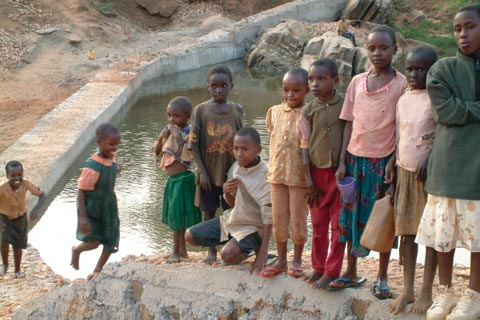Drop by drop, Kenyans struggle with climate change
Drop by drop, Kenyans struggle with climate change
 Community-built sand dam in Kenya's Machakos district: The simple dams allow villagers to protect groundwater levels, as drier weather patterns prevail.
Community-built sand dam in Kenya's Machakos district: The simple dams allow villagers to protect groundwater levels, as drier weather patterns prevail.It is still early on a hot and dusty Wednesday morning, but the temperature is already above 35 degrees centigrade. Residents say that it rained just a month ago, although there is no evidence of this. Plants have shed their leaves and all the green vegetation has now changed colour.
Seven-year-old Moli Kituvi strides with confidence in search of water, her container held tightly by one arm. Because of the harsh conditions in this semi-arid district some 400 kilometres from the capital, Nairobi, one would expect there to be a long walk ahead of her. But in the near distance lies a stretch of green vegetation. Napier grass, sorghum and other greenery grow in a small area next to a dry seasonal river.
With her calabash Moli starts scooping sand from the dry riverbed, one scoop after another. Close to 20 centimetres down, water finally seeps out. "I only have to wait less than five minutes, then the water will be very clear," says Moli with a smile. Indeed, she soon fills her bucket. With her task over, she says, "Now I can go to school."
Sand dams
Moli does not understand why she is able to help her mother fetch water in such a dry area. But Kavinya Kata, 35, who has herded her cattle to the same spot to quench their thirst, does. She cites the sand dams built along the seasonal river course that have changed the local environment — and the residents' lives — for the better.
"For years, water would flow down the stream after heavy rains in the mountains, but the community did not have techniques for conserving the water," Ms. Kata reminisces. But partly thanks to the sand dams, the community has now become self-sustaining.
With technical advice from the non-governmental SASOL Foundation, local community members selected the site for the sand dams. They elected a committee that supervised their construction, mobilized villagers to build them and now ensures that they are maintained. Built of sand across river drainage channels, the dams allow water to percolate into the surrounding soil and raise groundwater levels. And because the water is stored below the surface, evaporation is minimized.
More vegetation also grows. Italuu Kakai, a farmer, has come to the area to gather napier grass for his heifer tethered at home. Villagers can draw water from a nearby hand pump, installed by the SASOL Foundation.
Kitui's sand dams are not the only ones in the region. Some 55 kilometres away, in Maito, a self-help group is also reaping the benefits of the technology to improve farming. "For years the weather has been changing for the worse," notes Ngina James, a leader of the group. "Year in, year out, the rains have become scarce. So we had to find alternatives to survive in these harsh weather conditions." Using sand dams is one way for his group's members to tackle the challenges related to climate change.
Countering drought
Kitui has also experienced more difficult weather. Historically the district enjoyed seasons of short rains between October and December and long ones between March and May. But for the last 15 years the rainfall has become more erratic, with annual totals ranging between 250 and 750 millimetres. Dry spells have become more common during the rainy seasons, and the district has been hit by drought. Residents fear that the situation is likely to get worse.
According to Mutinda Munguti, head of the SASOL Foundation, sand dams can be an important asset to residents and can help bring significant changes to the local environment. The technology, he says, "eliminates water shortages and increases moisture content in the soil, thus increasing land productivity." And by increasing the vegetative cover, he adds, it can also reduce land degradation.
Severe weather conditions are becoming more common across Kenya. According to the government's National Climate Change Response Strategy, released in 2010, recurrent droughts have shortened the country's cycles of famine. It was 20 years between the severe droughts of 1964 and 1984, and then 12 years until the next one in 1996. Two more droughts came in 2004 and 2006. From 2007 to 2009 they came yearly, obliging the government to distribute 528,341 metric tonnes in food relief.
"As a result of climate change, there will be increased frequency and intensity of extreme weather conditions, like drought and floods," explains Ayub Macharia, the acting head of the National Environment Management Authority. This in turn will harm food security, the stability of food systems and people's access to food, in various direct and indirect ways. Mr. Macharia warns that the costs to society and the economy will be immense, unless more communities take action to reduce the impact of climate change.
The government, through its climate change strategy, is helping local communities with technical information and early warnings about changing weather patterns. It also plans to complement villagers' efforts on a wider scale: digging channels to transfer water from surplus to deficit areas, building municipal water-recycling facilities to reduce usage, constructing waterways, reservoirs and other infrastructure to retain rainwater, and protecting riverbanks and water catchment areas from degradation.
Together with local undertakings, such efforts not only help protect the environment, but can also enhance people's livelihoods, notes Mr. Munguti. "In communities with sand dams and other complementary services, agriculture is a less risky enterprise now."










